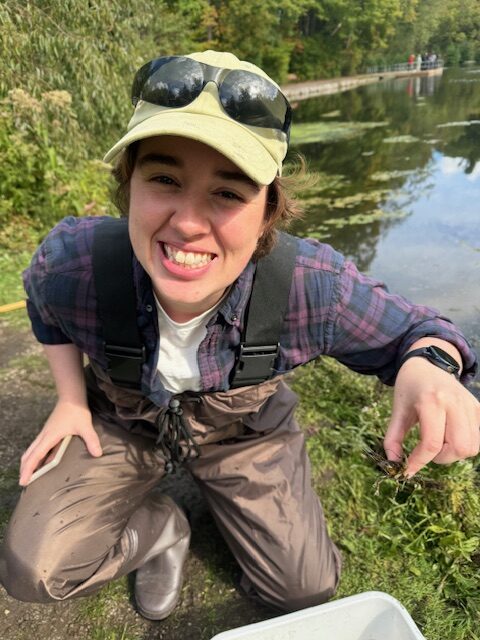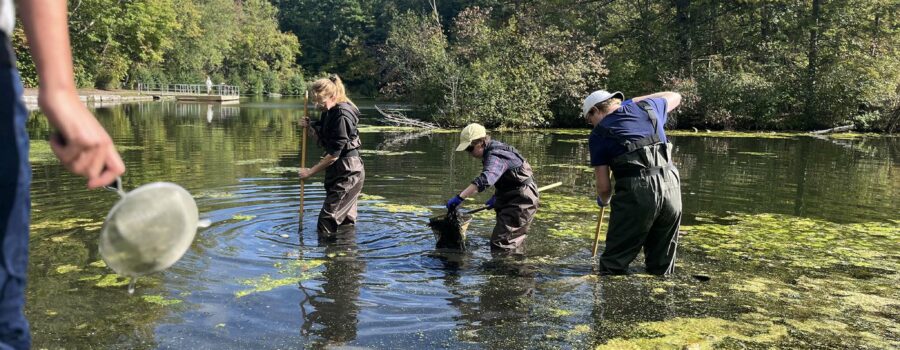 Budding environmental technicians had the opportunity to learn from Niagara College faculty and students during a field trip to St. John’s Conservation Area in Fonthill.
Budding environmental technicians had the opportunity to learn from Niagara College faculty and students during a field trip to St. John’s Conservation Area in Fonthill.
The October 2 experience was organized by NC’s School of Environment and Horticulture and Student Recruitment team, and the Niagara Catholic District School Board, giving second-year students from the College’s Environmental Technician program and a group of grade nine science students from Saint Francis Catholic Secondary School the chance to explore a beautiful local ecosystem. The opportunity was also a chance for all students to learn more about careers in environmental conservation and protection.
The trip was part of the NC students’ environmental monitoring and hydrology classes and allowed students to practice situational skills outside of the classroom.
“St. John’s Conservation Area is owned and managed by the Niagara Peninsula Conservation Authority (NPCA) and they issue a research permit to allow us to conduct academic research on their property,” said NC Professor and Program Coordinator Jocelyn Baker, who teaches the environmental monitoring class and has helped organize the experience over the past several years.
St. John’s provides an ideal setting to put theory into practice. The site is situated within the Niagara Escarpment Biosphere, the Carolinian Life Zone, and is part of the upper Twelve Mile Creek watershed – the only cold-water stream in Niagara where brook trout are native species.
While on site, the Saint Francis students were matched with Environmental Technician students, who mentored and guided them through four different stations led by NC faculty from the program. The stations offered an opportunity for the NC students to practice their skills by implementing some of the field and lab techniques they’ve been studying in the classroom.
Trish Hayes, Sarah Koudys and Jenn Volpato ran the first station on analytical chemistry, which looked at the numerical values of key compounds within water, phosphates, nitrates and sulphates.
Andrea Sinclair and Martin Smith led station two on field sampling and documentation, where students gathered water quality measurements, including pH, conductivity or dissolved oxygen, and samples that were used at some of the other stations around the waterbody.
Gab Robert taking photo documentation of a crayfish before safely returning it home to the pond
At station three, Jocelyn Baker took students through a popular activity on benthic invertebrates, bottom dwelling species. Here, students gathered water samples from the pond and identified the species they found, some of which can offer insights into the health a system.
“My favourite part was learning about benthics,” said NC student Gab Robert. “I never really liked insects before, but we were sent out into the pond with our waders and a net to see what benthics we could find, as it is a way to assess the water quality. When I came back out, I caught my very first crayfish. I learned how to handle it properly and released it back into the water.”
The final station with Annie Michaud focused on hydrology, the flow of water out of the pond. This can provide insight into the type of species present in a system, such as brook trout in the upper Twelve Mile Creek watershed, explained NC student Ryan Pendlebury.
“This species has been a staple of Indigenous communities in the area for centuries, and one that prefers fast moving cold water,” said Pendlebury. “The flow rate of the system helps identify if the correct parameters are being met for this species to thrive.”
The Saint Francis students study ecosystems as part of the grade nine de-streamed curriculum. The field trip introduced the students to real-world scenarios and potential programs and pathways at NC.
“The St. John’s Conservation trip was such a great opportunity! We learned things that only college level students and professors can show and used equipment that isn’t available in other schools!” shared grade nine student Sophia Aranda. “We learned so many new things like how to test water chemicals, looking at invertebrates and testing water speed. It also opens up so many ideas for our futures and job opportunities later in life.”
“This was a great experience for us and very interactive. We were very lucky to join Niagara College on this trip and hope that we’ll get another opportunity like this in the future,” said grade nine student Isabella Quezado Simao.
NC’s Environmental Technician students enjoyed sharing their program experiences and knowledge with the group from Saint Francis.
“It was incredibly rewarding to be able to share and learn with local high school students,” shared NC student Kaitlin Gracey. “Watching them learn and develop a passion for the outdoors was inspiring, I hope more young people are able to love and learn about the outdoors!”
“Working with the high school students offered a chance to switch our role from students to teachers, an important test of our knowledge and understanding of what and why we do things,” added Pendlebury.
“Each station was a snapshot of the system and helped comprise the overall big picture. Working with these students meant we could explain why each parameter mattered, why doing something in a specific way was important as well as our own interests in the program.”

The group from Saint Francis at St. John’s Conservation Area























